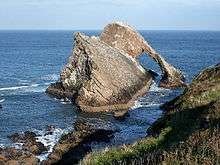Bow Fiddle Rock


Bow Fiddle Rock is a natural sea arch near Portknockie on the north-eastern coast of Scotland. It is so called because it resembles the tip of a fiddle bow.[1]
It is composed of Quartzite, a metamorphic rock which was originally quartz sandstone.[1] This rock is part of the Cullen Quartzite formation which is seen along the coast between Buckie and Cullen and is some 2,400m thick and dates from the Neoproterozoic Era, 1,000 to 541 million years ago.[2]
These rocks were folded when the ancient continents of Laurentia and Avalonia collided during the Caledonian orogeny. They later became exposed at the surface where sea and weather eroded the structure seen today.[1]
The rock formation is both a tourist attraction and nesting place for sea birds including herring gulls, great black-backed gulls and lesser black-backed gulls.[3]
References
- 1 2 3 "Bow Fiddle Rock, Portknockie". Scottish Geology. Scottish Geodiversity Forum. Retrieved 13 September 2015.
- ↑ "Cullen Quartzite Formation". British Geological Survey. Natural Environment Research Council. Retrieved 13 September 2015.
- ↑ "BOW FIDDLE ROCK - PORTKNOCKIE". Britain Explorer. Curious Britannia Ltd. Retrieved 13 September 2015.
Coordinates: 57°42′24″N 2°51′1″W / 57.70667°N 2.85028°W